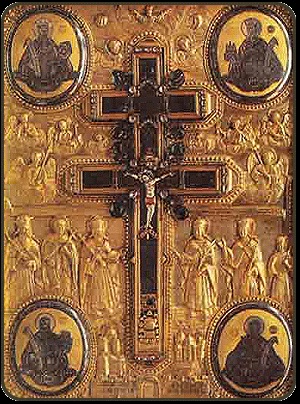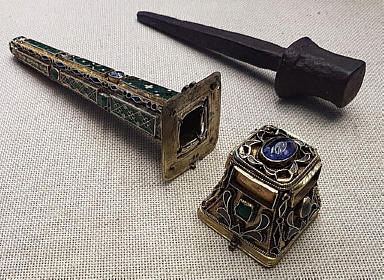Relic (noun) from Old French relique, from Late Latin reliquiæ "the remains of a martyr," from classical Latin reliquus "that which remains" related to relquere from re "back" + linquere "to leave"
__________________________
A relic usually
consists of the physical remains of a saint or the personal effects of
the saint or venerated person preserved as a tangible
memorial. Often it is merely something that the individual may have
briefly touched. A reliquary is
that which houses one or more religious relics.
Forgery has been associated with relics almost from the very beginning. Relic-collectors became prey to the unscrupulous, and some extremely high prices were paid. In the fifthe century, St.Augustine was denouncing impostors who wandered around disguised as monks selling spurious relics. In the eighth century, Charlemagne ordered that "the false names of martyrs and the uncertain memorials of saints should not be venerated" The Fourth Lateran Council (1215) of the Catholic Church condemned counterfeit relics.
By the middle of the 16th century, the number of relics in Christian churches became enormous, and there was practically no possible way to distinguish the authentic from the fraud, since both of them had been in the churches for centuries and were objects for worship. In 1543, John Calvin wrote about fake relics, describing the state of affairs with relics. He said that apparently the saints have two or three or more bodies with arms and legs, and even a few extra limbs and heads
Forgery has been associated with relics almost from the very beginning. Relic-collectors became prey to the unscrupulous, and some extremely high prices were paid. In the fifthe century, St.Augustine was denouncing impostors who wandered around disguised as monks selling spurious relics. In the eighth century, Charlemagne ordered that "the false names of martyrs and the uncertain memorials of saints should not be venerated" The Fourth Lateran Council (1215) of the Catholic Church condemned counterfeit relics.
By the middle of the 16th century, the number of relics in Christian churches became enormous, and there was practically no possible way to distinguish the authentic from the fraud, since both of them had been in the churches for centuries and were objects for worship. In 1543, John Calvin wrote about fake relics, describing the state of affairs with relics. He said that apparently the saints have two or three or more bodies with arms and legs, and even a few extra limbs and heads

The largest piece of the True Cross is located in the Holy Monastery of Xeropotamou, on Mount Athos in Greece
MORE RELICS
Holy Grail
The grail is most commonly identified as the cup that Jesus drank from at the Last Supper and that Joseph of Arimathea used to collect Jesus’s blood when he was crucified. See more
Holy Shroud
The Shroud of Turin is a centuries old linen cloth that bears the image of a cruci-fied man. A man that millions believe to be Jesus of Nazareth. See more
Spear of Destiny
also called Spear of Longinus,. It is said to be the lance that pierced the side of Christ at the Crucifixion.
Pieces of the True Cross
Reputedly the wood of the cross on which Jesus was crucified. Legend claims that the True Cross was found by St. Helena, mother of Constantine the Great, during her pilgrimage to the Holy Land about 326 AD. By the 8th century the accounts were enriched by legendary details describing the history of the wood of the cross before it was usedfor the Crucifixion. These accounts gave rise to the sale of its fragments which were sought as relics.John Calvin pointed out that all the fragments, if put together, would fill a large ship.This claim was countered by some Roman Catholic theologians who claimed that the blood of Christ gave to the True Cross a kind of material indestructibility, so that it could be divided indefinitely without being diminished. Such beliefs resulted in the multiplication of relics of the True Cross and fragments were deposited in most of the great cities and in a great many abbeys.
Reliquaries designed to hold the fragments likewise multiplied, and some objects of this kind survive.

Holy nail in the High Cathedral of Saint Peter in Trier,Germany
Holy Nails
The Holy Nails have become an object of veneration among many Christians and have been pictured in paintings and have supposedly recovered.
Very little reliance can be placed on the authenticity of the thirty or more holy nails which are still being venerated, or which have been venerated until recent times, in such treasuries as Santa Croce in Rome, or those of Venice, Aachen, the Escurial, Nuremberg, Prague, etc.
Probably the majority began by professing to be facsimiles which had touched or contained filings from the originals.